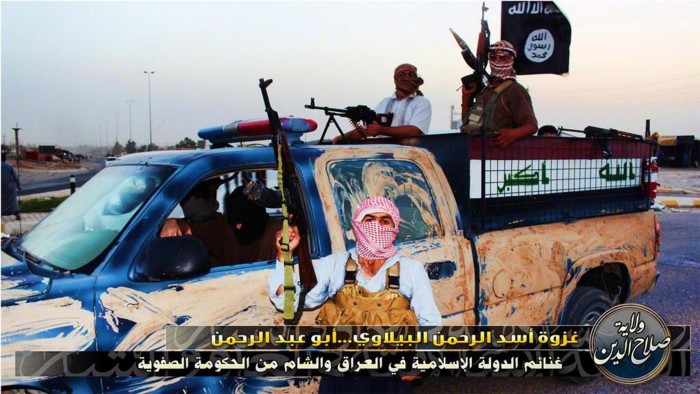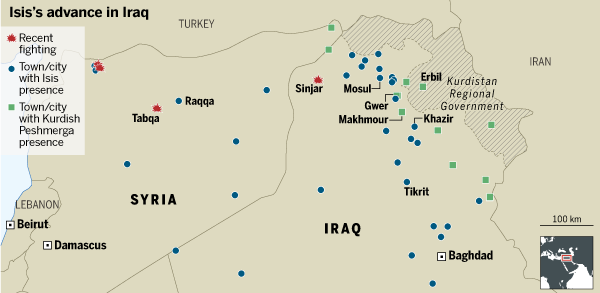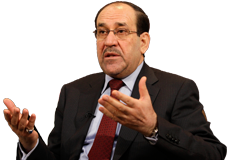Isis: Armed and dangerous

Roula Khalaf, Editor of the FT, selects her favourite stories in this weekly newsletter.
The Islamic State of Iraq and the Levant, known as Isis but transformed into the Islamic State since it declared its caliphate at the end of June, has turned into a strategic threat of the first magnitude, writes David Gardner. What looked like a black-shirted horde of jihadi fanatics, taking opportune advantage of a demoralised army in a dismembered Iraq, is a movement of a qualitatively higher order than al-Qaeda, dwarfing anything the followers of Osama bin Laden were able to throw at the Middle East and the world.
Isis is consolidating its hold over a third of Syria, which it used as the springboard for its surge over the Iraqi border in June. Now it is putting down roots in almost a third of Iraq, and striking east into Kurdistan and west into Lebanon. The Iraqi army melted in the face of this onslaught, surrendering Mosul, Tikrit and a string of towns in the north and centre of the country as well as an arsenal of US-supplied heavy weapons, leaving Iraq wide open to this jihadi menace.
The lightning advance of these Sunni supremacists has caught defenceless minorities, such as Christians and the Yazidi sect, in its path, facing them with the ultimatum to convert or die. Isis openly threatens the Shia – a majority in Iraq but a minority in Islam – with extinction. Fanning out with discipline and deliberation from its cross-border stronghold in the upper Euphrates valley, battle-hardened in Syria and tactically astute, Isis is well on the way to creating a new Afghanistan in the heart of the Middle East, and opening a corridor to the east Mediterranean.
This formidable force has taken full advantage of a multi-dimensional vacuum, marked by an absence of state and loss of shared national narrative in Syria and Iraq, the enfeebled influence of big powers on the region, and the lack of credible, mainstream Sunni leadership. In Syria and Iraq, overwhelmed by a tidal wave of Sunni-Shia sectarian poison, institutions of state have collapsed, throwing citizens back into the arms of sect and militia, clan and tribe.
Isis is feeding on the grievances of two communities. The first is Syria’s Sunni majority which feels abandoned by the west in the rebellion to topple Bashar al-Assad’s regime and has been beaten back with the help of Iran and its allies. The jihadi group is also exploiting the rage of Iraq’s Sunni minority, pushed aside by increasingly sectarian Shia rule since the 2003 US-led invasion. The group is positioning itself as the only Sunni force able to break the Shia Arab axis built by Tehran from Baghdad to Beirut in the past decade.
The groundswell of Sunni support as Syria and Iraq implode has given Isis a mass base of which al-Qaeda could only dream. It is also well financed, from extortion, kidnapping for ransom, donations from the Gulf, and now from oil: it controls nearly all Syria’s oil and has seized five oilfields in Iraq. Its unbridled savagery, replete with mass executions, beheadings and crucifixions, is strategic, like a medieval army consciously establishing a reputation for massacring the inhabitants of towns that resist and sparing those that do not. It has further multiplied its forces in Iraq by fastening on to Sunni power structures, not just the alienated tribes but the residual networks of Saddam’s defeated army. But it is careful to eliminate potential rivals in Sunni ranks.
The al-Qaeda precursor of Isis self-destructed in Iraq after prioritising the slaughter of Shia and brutalising the Sunni tribes into revolt. Isis could yet over-reach, uniting regional actors against it. But it is moving with irresistible speed – much faster than deliberations in Baghdad to regroup behind a more inclusive government, or dithering in Washington about how and how hard to hit it. The Islamic State’s chilling timing, as the heart of the Middle East goes up in flames, will make it hard to dislodge.
Erbil: Kurdish haven transformed into a frontline
Inside Iraqi Kurdistan’s regional capital, wedding celebrations fill green parks and locals dine late into the night, writes Erika Solomon. But less than 30km away from Erbil the bustle fades into a ghost town patrolled by stern-faced fighters still grappling with unexpected defeat.
The rolling yellow plains outside the town of Khazir are lined with berms and trenches dug right up to the doorstep of a Kurdish “peshmerga” base. On a dusty hill nearby, rows of white plastic refugee tents stand empty.
Just 10 days earlier, this was a haven – the congested registration site for thousands fleeing the advance of Isis. Now, the checkpoint is a frontline.
“The fighting will start here again. We don’t know when, but it will be at night, under the cover of darkness,” says Roj Shawis, the weary commander and Iraq’s deputy prime minister. Like many older Kurdish statesmen, he is revisiting his retired military role to help fight Isis.
“This is a strategic point and we both want it: it controls the flat plains around here. It is the key to Erbil.”
The fighters seem unsure how to retake Khazir, but they say civil engineers are on standby to support a peshmerga offensive by quickly rebuilding a bridge, blown up by Isis, over the river that divides their position from the town. Fighters prepare by digging fresh trenches as Iraqi and US air strikes help beat back their foe.
Isis’s advance on Khazir brought it 20km into northern Iraq’s autonomous Kurdistan region from its stronghold in Mosul, the country’s second-largest city.
It is a small incursion compared with the group’s lightning advance across swaths of Iraq.

While it is unlikely Isis will advance further towards Erbil, it has already accomplished the psychological blow it sought – exposing the weaknesses of the region and its vaunted fighters, once seen as the only force capable of defeating the jihadi group.
Today’s peshmerga grew out of the guerrilla forces that fought for decades to gain regional autonomy. But they have not seen active combat for years.
The refugees once housed in Khazir’s neatly lined tents are now splayed across abandoned buildings and shops along the road to Erbil, sleeping on carpets and flattened cardboard boxes.
In Erbil, there is no longer a sense of imperviousness but neither is there panic. US air strikes last week helped the Kurds staunch the Isis onslaught and allowed them to retake the towns of Gwer and Makhmour, some 50km southwest of the city.
When fear briefly overtook Erbil, residents say some people desperate to escape traded gold for petrol, or sold their cars on the cheap for cash.
The city has regained its calm, however. Some areas are busier than before – swelled by those who fled the Isis advance. At the same park where families dance with newly-weds, some wary refugees camp under the trees.
“Officials tell us to go home, but we don’t trust them. They’re still here. How can we go back if they don’t?” asks elderly Hurah Mahmoud from Makhmour.
The abandoned streets of Makhmour have an eerie silence. But the peshmerga are regaining confidence as they reprise a role similar to their 1990s uprising and the 2003 US invasion – advancing under US air cover.
Fighters are undecided about how effective the US strikes will be in the long term. While Makhmour’s peshmerga were optimistic, some in Khazir worried that the small, fast moving and constantly shifting formations of Isis would be difficult to weaken with strikes.
“We need to be ready for any surprise,” says a fighter in Khazir, resting in the shade of an old UNHCR tent. “Our military expectations are that we can’t expect anything.”
Neighbours: How regional rivals aided the birth of Isis
Before this summer the regional actors with a stake in the future of the Levant were jostling for position, writes David Gardner. Iran, Turkey and Saudi Arabia were locked in proxy warfare in Syria and Iraq. Now that Isis has seized a third of both countries and set up a well-armed, oil-rich state that threatens them all, their stratagems cannot be seen as a success.
Officials from all three countries argue that theirs is not the original sin. The Anglo-American invasion of Iraq in 2003 upended the regional order, propelling the Shia into power in an Arab heartland country for the first time in centuries and rekindling the embers of the Sunni-Shia schism dating from the dawn of Islam. Western failure to back the mainstream Sunni uprising in Syria against Bashar al-Assad, when his regime wobbled between the summers of 2012 and 2013, opened the door to Isis taking over the Syrian rebellion and surging into an Iraq where Nouri al-Maliki’s US- and Iran-backed Shia Islamist government was persecuting the Sunni minority, purging its leaders and tearing up the power-sharing pact that was supposed to follow US withdrawal in 2011. But Iran, Saudi Arabia and Turkey added to the mess.
Iran, like the US, became complacent about the corrosive sectarianism of Mr Maliki, a Washington protégé before he became Tehran’s client, and the corruption that enabled Isis to easily rout Iraq’s army and rally the Sunni tribes. Under the crack al-Quds Force of the Islamic Revolutionary Guard Corps, Tehran concentrated on turning back the rebellion against the Assads. It used paramilitary allies such as Lebanon’s Hizbollah as its shock troops. Under General Qassem Soleimani it built up a network of loyalist militia in Syria, and is trying to replicate this in Iraq using Shia militia.
Saudi Arabia, an absolute monarchy underpinned by the Sunni absolutist Wahhabi clerical establishment, never resigned itself to the Shia takeover in Iraq, and devoted its efforts to bloodying Iran by helping to topple the Assads, Tehran’s Arab allies in Syria. It is unclear to what extent, if any, this policy funnelled money to Sunni radicals. But groups such as Isis received funding from Saudi sympathisers, as well as Saudi volunteers. Although the kingdom has banned this the damage has been done.
Turkey allowed jihadi volunteers to cross its border to fight in Syria and served as a hub for rebel forces. Persistent though unconfirmed reports placed Hakan Fidan, the Turkish intelligence chief and right-hand man of Recep Tayyip Erdogan, the prime minister elected president last Sunday, at the heart of this operation.
Mr Erdogan has become ever more strident in emphasising his Sunni, neo-Islamist credentials, even while his government is clamping down on jihadism. His 2013 plan to bind Syrian and Iraqi Kurds into a peace initiative with the large Kurdish minority in southeast Turkey – a Sunni buffer against the Shia axis to the south – now looks more like emergency insulation against Isis.
While Iran, Turkey and even Saudi Arabia have all welcomed the attempt to replace Mr Maliki with a more inclusive government in Baghdad, it looks like their respective spymasters did not see Isis coming.
Baghdad: Beset by poisonous politics
In theory, the government of Iraq should be an ideal partner in the fight against Isis and other radical Sunni insurgent groups, writes Borzou Daragahi. Policy makers in Baghdad can draw from billions of dollars in oil revenues to lavish on training and equipment for security forces and as handouts to disaffected populations that might flirt with rebels. The demographic make-up of Iraq, 60 per cent Shia and 20 per cent Kurd, is overwhelmingly hostile to the ideology of the Sunni Arab insurgents.
In reality, the Baghdad government’s potential strengths are also its weaknesses. Its oil money and sectarian political dynamics have served only to feed festering Sunni and Kurdish alienation, perceptions of corruption and the injustice that paved the way for Isis.

If the conflict in Syria is the incubator in which Isis grew out of its infancy, Baghdad’s dysfunctional policies hastened its adolescence. Any attempt by Washington to recruit the Baghdad government and its vast armies of Shia volunteers and militias in the fight against Isis could reinforce the idea among Sunni in Jordan, Egypt and Saudi Arabia that the US is taking sides in a sectarian war and draw even more recruits to the jihadi cause.
Until Iraq’s political problems are resolved, Baghdad could be a poisonous partner in the war against Isis, as many US policy makers appear to believe, even in light of the attempt to sideline Nouri al-Maliki this week by naming Haidar al-Abadi as premier-designate.
“The polarisation has been so severe I think it will be difficult for any politician to take the process forward,” says Ahmad al-Attar, defence and security analyst at the Delma Institute, an Abu Dhabi think-tank. “I doubt it’s realistic to get all these people together to tackle any one problem when they’re actually at each other’s throats.”
Following the catastrophic bombing of the Shia shrine in Samarra in 2006, Iraqis came together to halt the descent into civil war and marginalised Isis’s predecessor, al-Qaeda in Iraq, by recruiting Sunni to take up arms against them as part of sahwa, or the awakening movement. But that was at a time when 150,000 US troops were deployed in the country and diplomats could force the various leaders to sit in the same room. “Iraq doesn’t have the bureaucratic, security or technocratic expertise to pull something like that off,” says Mr Attar.
Isis is not considered likely to make the same mistake as its forebears in allowing the emergence of a new version of the awakening movement that was largely destroyed by Mr Maliki. It has already launched a campaign of assassination against former leaders of the movement and warned others not to participate.
Despite Sunni scepticism, the elevation of Mr Abadi offers a small possibility to begin changing the tone and direction of Iraq’s politics. “We have to give Abadi a chance with everything that is going on,” says Samir Obeidi, a moderate Sunni cleric in the capital. “Maliki was not able to do anything about it. Hopefully Abadi will.”
Washington: US seeks to limit military campaign
After several optimistic bulletins about how US air strikes had been pushing back jihadi forces in northern Iraq, General William Mayville Jr took the podium at the Pentagon on Monday to deliver a more stringent assessment, writes Richard McGregor.
“I in no way want to suggest that we have effectively contained or that we are somehow breaking the momentum of the threat posed by Isis,” said Gen Mayville in reference to the Isis jihadi group.
Gen Mayville, the director of operations for the joint chiefs of staff, comes from a branch of the military with a reputation for blunt truth-telling, to the discomfort of their political masters. “There is a long history of [joint operations directors] giving briefings which make White House civilians very nervous,” says Micah Zenko of the Council on Foreign Relations.
Barack Obama has constantly sought to reassure the US public that the military mission in Iraq will be limited, even as his administration has laid out a lengthy list of potential objectives.
The spread of Isis
For a detailed map of the jihadi group’s advance from Syria into Iraq, and how it threatens various regions, click here
At various times, the US has aimed to protect infrastructure, support Kurdish and Iraqi military forces, provide humanitarian relief, push the jihadi forces away from Baghdad and prevent the slaughter of civilians.
“There are maximalist objectives with limited forces,” says Mr Zenko. “That buffet of objectives just seems to take you down a path you don’t want to get taken down.”
Ultimately, the US will have to face the question implicitly raised by Gen Mayville in his Pentagon briefing – what force would be needed not just to halt Isis’s momentum but to take it on and demolish it.
Lindsey Graham, a hawkish Republican senator, says: “From the American national security perspective, it is impossible to have a successful outcome in Iraq without hitting and diminishing Isis. That seems to be a fact President Obama is incapable or unwilling to address.”
The immediate pressure to go after Isis seemed to dissipate on Wednesday when the Pentagon announced that the number of minority Yazidi people trapped by Isis forces on a mountain range was smaller than thought and therefore the need for a rescue mission was less urgent.
But even if Isis fighters have retreated slightly and, for the moment, blended into the local population to protect themselves from US air strikes, the growing weight of opinion in Washington favours going after them as the end game.
As David Rothkopf of Foreign Policy magazine puts it: “Three years ago Isis was a street gang. Now they are the most important terrorist group in the world.”
Ben Rhodes, the deputy national security adviser, has left the door open to the prospects of putting US troops on the ground, not to fight Isis directly but to protect communities from attack.
“But if you can put troops on the ground [near the Yazidis] you can put them anywhere – they are not the only at-risk population there,” says Chris Hill, the veteran US diplomat and a former US ambassador to Baghdad.
The US achieved one of its main objectives this week, helping unseat Nouri al-Maliki as prime minister, in the hope that his departure will produce a more inclusive government in Baghdad. But the US role is far from over.
“I think we are going to have some mission creep if we are going to achieve the destruction of Isis, and I don’t see how you can do that without troops on the ground,” says Mr Hill.
“The big disconnect is whether solving the [political] soap opera in Baghdad will result in a more effective Iraqi army.”
And without a more effective Iraqi army, the fight could fall to Washington again.
Comments